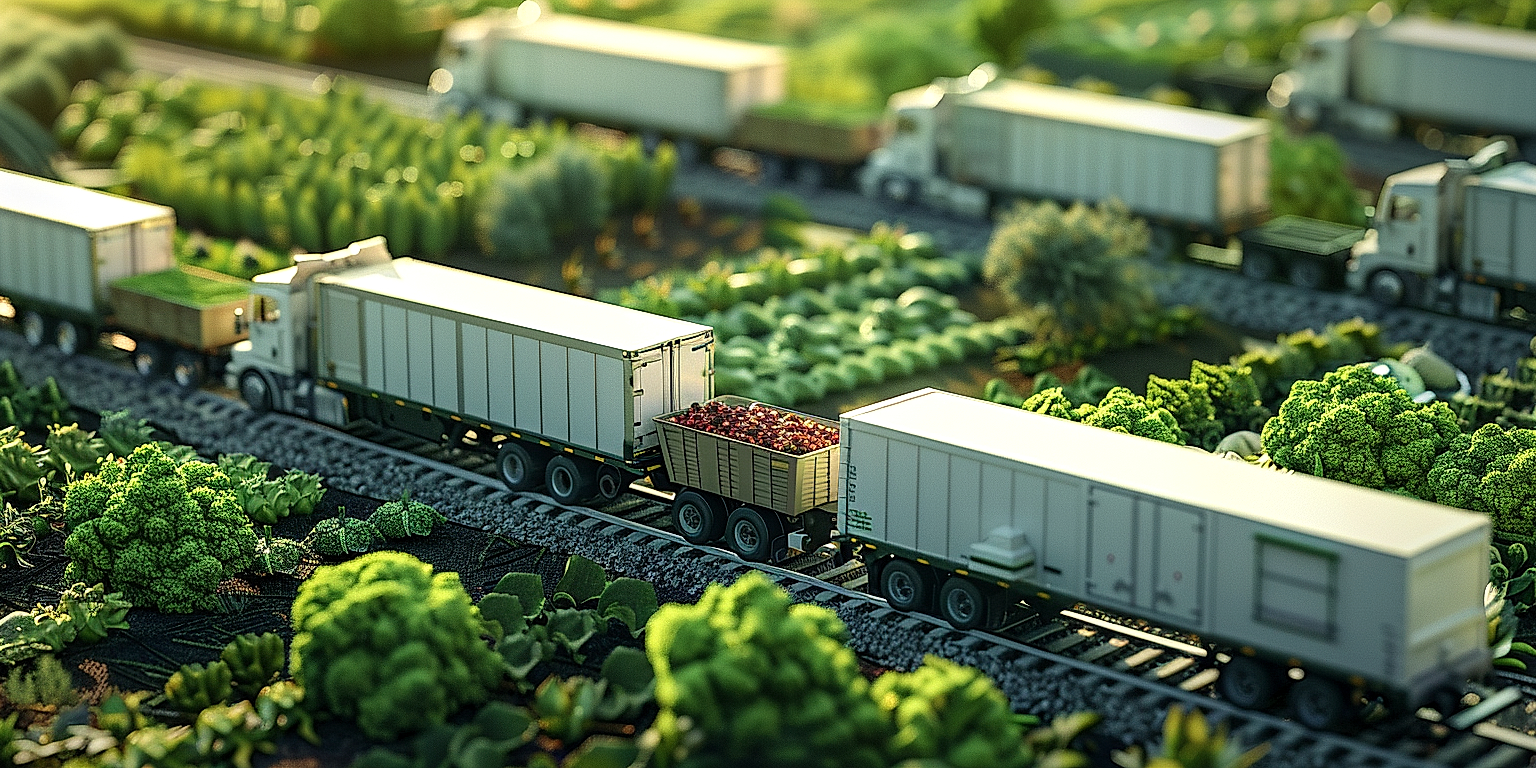The world of food supply is one synonymous with a complex web of activities, all aimed at ensuring fresh farm produce makes its way to the end consumer.
A critical component of this intricate network is logistics for produce processing.
However, it’s a sector fraught with considerable challenges that can disrupt efficiency and derail success.
Obstacles range from perishability issues and inconsistent supply, to transportation difficulties and industry regulations.
Understanding these impediments can pave way for strategic planning and effective crisis management within the supply chain.
This article will explore these challenges, shedding light on their underlying causes and potential solutions.
Challenges In Logistics For Produce Processing
1. Limited Shelf Life or Longevity of Produce
The limited shelf life of fresh produce presents a significant challenge to logistics in processing.
This limitation is often caused by the nature of the produce itself, which can only be preserved for a certain amount of time under specific conditions.
Efficiently transporting and delivering fresh produce within a constrained time window can be a logistical nightmare.
This issue is compounded by the consumer’s desire for freshness and the quality that suffers with each passing day after harvest.
Moreover, different types of fruits and vegetables have different shelf lives, making it a complex task to manage logistics.
Handling fresh produce becomes extremely demanding due to the constant race against time to deliver the products within their limited shelf life.
Considering the perishable nature of fresh produce, the time from field to grocery store becomes a key determinant of logistic efficiency.
As a result, the logistics strategy must ensure the least amount of time is wasted throughout the supply chain.
Delays in any stage of logistics – from harvest, processing, packaging, storing to distribution – can drastically shorten the shelf life of the produce and subsequently lead to potential revenue loss.
This is especially true for more delicate produce such as berries or leafy greens which have a shorter shelf life than other produce such as potatoes or apples.
Advanced refrigeration technology, although helpful, can only slow down the degradation process and not completely halt it.
Therefore, delays in logistics due to inefficient planning or unforeseen circumstances (like weather changes or transportation issues) significantly impact the shelf life of fresh produce.
Logistics professionals must therefore continuously monitor and adapt to changes in the supply chain to prolong the shelf life of the fresh produce while preserving their quality.
Moreover, the need for enhancing the shelf life of fresh produce compels logistics operators to look for innovative solutions such as controlled-atmosphere storage or exploring novel preservation technologies.
The pressure to reduce losses due to the limited shelf life of fresh produce not only demands precision but also a high level of responsiveness and flexibility in different stages of the logistics process.
In summary, the limited shelf life of fresh produce presents a pressing challenge in logistics; from timing, handling, storage to distribution, and is a major factor that determines the success of produce processing logistics.
2. Inefficient Supply Chain Management System
An inefficient supply chain management system can pose as a significant challenge in the logistics sector for produce processing.
It is the backbone of a business, and if not properly managed, can result in significant losses.
Logistics for produce processing has a complex chain of operations starting from sourcing, transportation, and right to the end-consumer.
If there’s a hitch anywhere in these operations, it culminates into a ripple effect that runs to the end of the chain.
Delays, increased costs, product wastage, and customer dissatisfaction may be typical examples of inefficiencies.
Produce processing requires an effective and efficient Supply Chain Management (SCM) system to ensure smooth operations and gain competitive advantage.
An efficient SCM will help in making better use of resources, reducing waste, and improving customer service.
Furthermore, it is integral to maintaining an uninterrupted flow of the produce from the field to the consumer.
Challenges in logistics for produce processing are compounded if the supply chain is poorly managed.
These challenges include inability to track produce, untimely delivery, inefficient quality control, and unforeseen logistical issues.
Consequently, an inept supply chain management system threatens the sustainability of the produce processing industry.
It is essential to have timely and accurate information along every point in the supply chain to ensure less wastage and higher efficiency.
A key aspect of handling this challenge is the adoption of technology, such as blockchain technology, to improve visibility and reduce uncertainties.
Apart from technological advancements, having a resilient supply chain requires strategic planning, risk management measures, and establishing strong partnerships.
These kind of plans and partnerships facilitate the smooth functioning and streamlining of operational processes, maximizing the efficiency of the supply chain.
Thus, it is quite evident that an inefficient supply chain management system presents a plethora of challenges in logistics for produce processing, and addressing these challenges requires intelligent planning and due diligence.
3. Inclement Weather Affecting Transportation
One of the major challenges in logistics for produce processing is the unpredictable and often severe nature of weather conditions.
These weather patterns significantly impact the transportation of fresh produce.
Inclement weather, such as heavy rain, snow or extreme heat, can cause delays in the delivery of produce, leading to potential spoilage and loss of product.
Produce such as fruits and vegetables are highly sensitive to temperature changes and require a controlled environment during transportation to retain their freshness.
Major storms or natural disasters can halt the entire supply chain, impacting not only the delivery process but also the production and harvesting of the produce.
A brief period of adverse weather can disrupt the entire logistics chain and render months of planning ineffective.
This results in substantial financial losses for companies, affecting their profits significantly.
Roads become inaccessible, shipping routes are dangerous during storms, and air transport is grounded during poor weather.
Such situations put a great deal of pressure on logistics managers to devise solutions that ensure the timely delivery of fresh produce.
Fluctuating weather also forces adjustments to delivery schedules and routes, increasing the cost and complexity of transportation.
To overcome these challenges, companies need to invest in sophisticated prediction models and build a flexible and adaptive logistics strategy.
Constant monitoring of weather conditions and quick response to changes can help minimize the impact of inclement weather.
Creating alternative plans for transportation under different weather conditions is also essential to ensure the freshness and quality of the produce upon delivery.
These strategies and contingency plans can help navigate the challenges imposed by inclement weather.
However, even with these solutions, the unpredictability of weather will always pose significant risks and uncertainties in the logistics of produce processing.
4. Lack of Proper Storage Facilities
One significant challenge for logistics in produce processing is the lack of proper storage facilities. This issue often goes unseen but significantly impacts the quality of the product and the efficiency of its delivery.
Poor storage equipment can lead to loss of quality in the stored produce, thereby decreasing its market value.
Such quality degradation can occur from factors like temperature fluctuations, improper air circulation, or even a deficiency of controlled atmosphere storage, which regulates the amount of oxygen surrounding the produce.
A lack of purpose-built storage spaces can also lead to issues in produce processing. Insufficient space leads to overcrowding and hence to bruising or damaging the produce.
This challenge becomes more prevalent in regions lacking infrastructure for large-scale produce storage and logistic activities.
It’s noteworthy to mention that this deficit of adequate storage space is directly linked to inefficient supply chain management and exacerbates the problem of limited shelf life.
A lack of technologically advanced storage facilities equipped with features like real-time temperature monitoring and automatic temperature control is another major hurdle.
This deficit prevents efforts to maintain optimum conditions for preserving the freshness and quality of produce throughout the supply chain journey.
Furthermore, inadequate storage facilities significantly hinder the optimization of the supply chain as they limit the effectiveness of innovative approaches like batch tracking and just-in-time logistics.
Moreover, storage facilities’ design often falls short in preserving the hygienic standards required for fresh produce handling and processing.
This inadequacy can result in cross-contamination issues and ultimately lead to a compromise in food safety.
Necessarily, inadequate or substandard storage facilities exacerbate the issue of waste in the produce supply chain.
They not only contribute to increased product damage but also to a rise in costs due to the resulting inefficiencies.
The necessity to maintain a constant cold chain for preserving the produce’s quality during logistics further complicates this issue.
This demand for a consistent cold chain could lead to increased energy consumption and carbon emissions, which pose a challenge for eco-conscious supply chains.
Finally, the lack of proper storage facilities commonly results in inadequate handling of produce post-harvest. Such poor handling can lead to a significant decrease in quality and an increase in wastage during the produce’s journey from farm to fork.
5. Regulatory and Sanitary Requirements
The regulatory and sanitary requirements posed by various local, national, and international bodies present significant challenges in logistics for produce processing.
Understanding and complying with the varying levels of standards and regulations can prove complex and resource-intensive.
Each country typically has its own standards for importation, processing, packaging, and distribution of various produce items.
These regulations can include anything from ingredients and labeling requirements to food safety guidelines and sanitary conditions of the processing facilities.
For instance, the US Food and Drug Administration (FDA) imposes stringent standards for the handling and processing of food items to ensure their safety and quality.
The challenge is compounded further as many enterprises also need to meet the standards of their destination markets.
The need to keep up with frequently changing regulatory environments and adopting appropriate adjustments in their operation makes the regulatory process quite challenging for the producers.
Any failure in adhering to these standards not only puts the business at risk of violating the law, but it also puts the public health at risk, leading to recalls and damage to the company’s reputation.
Furthermore, establishing the necessary tracking and tracing systems to ensure transparency and accountability in case of a food safety issue can be onerous.
Ensuring the equipment used in processing is up to sanitary standards presents another unique challenge.
All equipment must be properly cleaned, maintained, and inspected on a regular basis to avoid the risk of bacterial contamination.
Apart from the physical elements, there is a significant need for necessary paperwork and documentation as part of regulatory and sanitary requirements.
Documentation such as certificates of authenticity, lab testing reports, and certificates of origin must be appropriately managed.
Each of these challenges necessitates a significant investment in terms of time, effort, and financial resources.
Despite these challenges, it is crucial to understand that these regulatory and sanitary requirements are in place to ensure the health and safety of the public.
It implies that businesses operating in the produce processing industry need to prioritize regulatory compliance and maintain the highest standards of sanitation and hygiene.
6. High transportation and fuel costs.
The agricultural supply chain is heavily impacted by the rising transportation and fuel costs.
This predicament can significantly deepen the challenges in the logistics for produce processing.
Due to the perishable nature of these goods, they need to be transported quickly and efficiently.
The immense fuel costs make this fast-paced transport increasingly expensive.
Furthermore, these escalating costs are often passed onto the consumer in the form of higher prices.
Consequently, high transportation and fuel costs can negatively impact the affordability of fresh produce.
This could in turn, deter consumers from purchasing, creating a downward spiral of demand.
Moreover, transportation involves not only the movement of raw materials, but also goods at every stage of production.
So, any increases in these costs directly impact every part of the produce processing system.
This situation is further complicated by the unpredictability of fuel prices.
Fuel prices are variable and linked to a multitude of external factors, such as political stability, global crude oil prices, and natural disasters.
Therefore, the capability to predict, budget, and manage these prices becomes integral within the logistics of produce processing.
Yet, this proves challenging due to their unstable and volatile nature.
As such, higher fuel and transportation costs can significantly strain finances and make it more difficult for businesses to maintain narrow margins.
Sometimes, they could even outweigh the profits gained from produce processing.
Therefore, high transportation and fuel costs present a host of challenges in the logistical side of produce processing.
7. Global sourcing and international delivery.
In the realm of produce processing, global sourcing and international delivery offer a unique set of challenges.
The process involves sourcing produce from various parts of the world, which necessitates a complex logistics system.
These systems must often cope with highly volatile and unpredictable factors, such as climate changes, political instability, and fluctuating exchange rates.
The global nature of this operation also demands constant communication between different entities in the supply chain, from farmers and suppliers to distributors and retailers.
An inefficient communication system can cause significant delays and frustrations.
The quality and freshness of the produce are other critical elements that make global sourcing and international delivery extremely challenging.
Due to the long-distance shipment, ensuring that produce arrives at its destination in the best possible condition is a meticulous task.
Moreover, the need for specialized transportation equipment, such as refrigerated trucks or ships, to maintain the optimal environment for the produce during transit, adds another layer to the cost and logistical complexity.
Navigating through the different international trade regulations is another aspect that complicates the process.
The rules and regulations can vary significantly from one country to another, thus requiring immense knowledge and understanding of international trade laws.
Compliance failures can lead to severe penalties and disruption in the supply chain.
Moreover, global sourcing and international delivery expose the supply chain to more risk factors, such as delays at customs, theft, and damage during transit.
Therefore, a comprehensive risk management strategy is essential to mitigate these risks and maintain a smooth supply chain operation.
The fluctuation in fuel prices also adds to the cost and complexity of international delivery.
Furthermore, dealing with multiple languages, cultural differences, and time zones can pose communication challenges, implying the need for robust strategies to deal with them.
While global sourcing and international delivery can indeed open up new markets and opportunities, they undoubtedly also intensify the challenges in logistics for produce processing.
The Bottom Line
Given these considerations, it’s clear that several key factors contribute to the complexity and challenges of agri-food supply chains.
Shelf life limitations, inefficacy in supply chain management, inclement weather disruptions, and inadequate storage solutions all contribute to substantial logistical difficulties.
On top of this, regulatory and sanitary requirements often impose additional burdens, alongside climbing transportation and fuel costs.
Lastly, the increased trend towards global sourcing and international delivery further complicates and expands the scope of these issues.
Addressing these challenges will require a multifaceted approach that fosters innovation, promotes efficiency, and supports the resilience of global agri-food supply chains.




